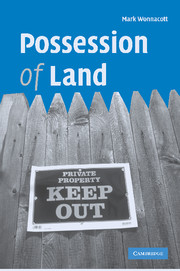Book contents
- Frontmatter
- Contents
- Preface and acknowledgments
- Table of cases
- Table of statutes
- Table of statutory instruments
- 1 Meaning of possession
- 2 Protection of possession
- 3 Possession, title and freehold land
- 4 Leases and licences
- 5 Mortgages and charges
- 6 Equity and trusts
- 7 Birth and death, dissolution and insolvency
- 8 Adverse possession and prescription
- 9 Possession judgments
- 10 Summary and conclusions
- Index
7 - Birth and death, dissolution and insolvency
Published online by Cambridge University Press: 13 August 2009
- Frontmatter
- Contents
- Preface and acknowledgments
- Table of cases
- Table of statutes
- Table of statutory instruments
- 1 Meaning of possession
- 2 Protection of possession
- 3 Possession, title and freehold land
- 4 Leases and licences
- 5 Mortgages and charges
- 6 Equity and trusts
- 7 Birth and death, dissolution and insolvency
- 8 Adverse possession and prescription
- 9 Possession judgments
- 10 Summary and conclusions
- Index
Summary
Introduction
This chapter is about changes in status and involuntary dispositions. It is about the circumstances in which a person may acquire a right to possess an estate simply as a result of a change in that person's status, or the status of someone else; and the consequences for the person who is in fact in possession of the estate when that happens.
Birth
An individual does not have any legal personality unless and until he or she is born alive. All of the rights which might be acquired and enforced subsequently are necessarily contingent on being born alive, and no one can be sure that will happen before the event.
So before then, an individual cannot have a vested right to possess any estate, whether at common law or in equity. The right cannot be ‘vested in possession’, because the vesting is necessarily contingent on the birth, and contingent rights are not even ‘vested’; far less are they ‘vested in possession’.
It follows that nor can anyone be ‘in’ possession of any estate before he or she is born, for, until then, that individual cannot ‘be’ anything.
At the moment of birth, that changes. An estate may vest in an individual for a interest in possession at the very moment when he or she is born alive, without the need for any further intervention.
- Type
- Chapter
- Information
- Possession of Land , pp. 107 - 124Publisher: Cambridge University PressPrint publication year: 2006



